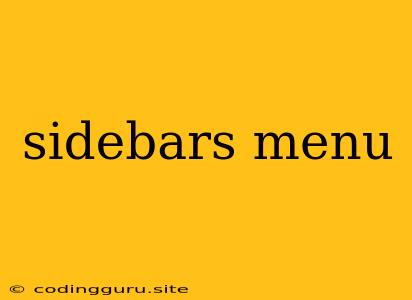Enhancing User Experience with Sidebars: A Comprehensive Guide
Sidebars are an integral part of modern web design, offering a dynamic way to organize content and enhance user navigation. But how do you create effective sidebars that seamlessly blend with your website's aesthetics and functionality? Let's dive into the world of sidebars, exploring their purpose, design principles, and implementation strategies.
Understanding the Purpose of Sidebars
Think of sidebars as the backstage of your website, housing essential tools and information that users need to navigate and interact with your content. They serve several key purposes:
- Navigation: Sidebars act as a central hub for navigating through different sections of your website, providing a clear and intuitive path for users to explore your content.
- Information Access: They can display important information like recent posts, social media links, search bars, or user profiles, ensuring quick and easy access for users.
- Organization: Sidebars help categorize content and provide a structured way to present information, making it easier for users to find what they need.
Design Principles for Effective Sidebars
While sidebars are valuable, they need to be designed carefully to avoid cluttering the user experience. Here are some key design principles to consider:
- Keep it Concise: Limit the number of items in your sidebar to only essential elements. Too much information can overwhelm users.
- Clear Hierarchy: Organize your sidebar elements in a logical order, using visual cues like headings, spacing, and color to guide users through the information.
- Accessibility: Ensure your sidebar elements are easily accessible to users with disabilities. Use appropriate font sizes, color contrast, and keyboard navigation.
- Responsive Design: Ensure your sidebar adapts seamlessly to different screen sizes and devices, maintaining its usability on mobile, tablet, and desktop platforms.
Types of Sidebars
Sidebars can come in various forms, each serving a specific purpose:
- Navigation Sidebars: These sidebars are primarily used for navigating through your website's content, often featuring links to different sections, categories, or pages.
- Content Sidebars: These sidebars display supplementary content related to the main content area, such as related articles, tags, or author information.
- Widget Sidebars: These sidebars offer flexible customization, allowing you to add various widgets like social media feeds, search bars, or contact forms.
Implementing Sidebars
Implementing sidebars can be done using various methods, depending on your website's development framework.
- HTML and CSS: You can create a basic sidebar using simple HTML and CSS, positioning it using floating elements or flexbox. This approach provides flexibility but might require more manual coding.
- CMS Plugins: Content management systems like WordPress offer plugins specifically designed for creating and managing sidebars. These plugins simplify the process, allowing you to drag and drop widgets and configure sidebar elements.
- JavaScript Frameworks: Frameworks like React or Vue.js provide powerful components for creating dynamic and interactive sidebars, allowing you to manage content and adapt to user interactions.
Examples of Effective Sidebars
Let's look at some real-world examples of how sidebars are used effectively:
- Blog Websites: Many blogs utilize sidebars to display recent posts, categories, archives, or author profiles, providing a streamlined way for users to navigate through content.
- Ecommerce Websites: Sidebars on ecommerce sites often showcase product categories, filters, or special promotions, helping users refine their search and quickly find what they need.
- Social Media Platforms: Sidebars on social media platforms often display user profiles, trending topics, or suggested connections, offering personalized content and enhancing user engagement.
Conclusion
Sidebars are a powerful tool for enhancing user experience and organizing website content. By understanding their purpose, designing them effectively, and choosing the right implementation methods, you can create sidebars that improve navigation, increase user engagement, and ultimately enhance your website's overall usability. Remember to keep it concise, maintain a clear hierarchy, and prioritize accessibility to ensure your sidebars are as user-friendly as possible.
